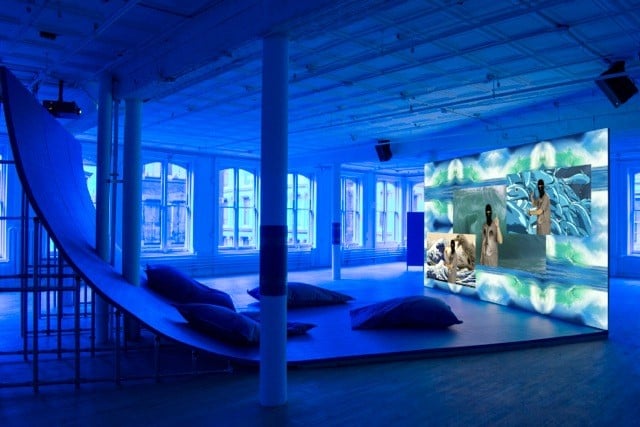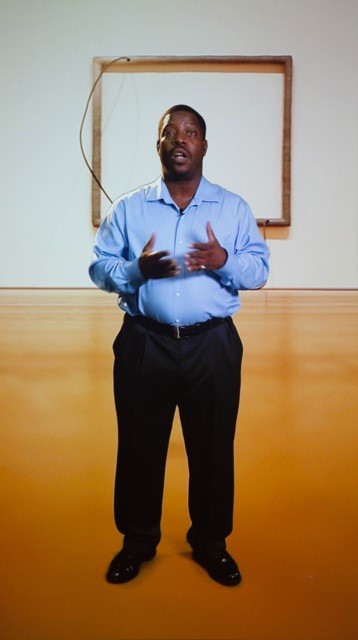Art & Exhibitions
Hito Steyerl’s Artists Space Show Mixes Money, Violence, and Art and Delights The Mind
Magic realism meets documentary in this enthralling if flawed show.

Photo: courtesy of Artists Space.
Magic realism meets documentary in this enthralling if flawed show.

Paddy Johnson

Enter the Greene Street location of Artists Space and the voice of martial artist Bruce Lee will greet you. “Empty your mind,” Lee instructs, his warm voice pouring out into the open gallery introducing us to Berlin-based artist Hito Steyerl’s video Liquidity Inc. (2014). Bathed in blue light from a large projection screen at the center of the space, the gallery is transformed into a cozy setting with bean bag chairs for visitors to rest in. In this environment, Lee’s instructions are very easy to follow. “You put water into the cup, it becomes the cup,” he says. “You put water into a bottle, it becomes the bottle; you put water into a teapot, it becomes the teapot.” Images of oceans, boxers sparring, word clouds, and art transition across the screen. “Water can flow or it can crash. Be water, my friend.”
Liquidity Inc. is one of seven works in this survey of Steyerl’s video work made between 2004 and the present. Lee’s mantra provides an underlying theme for the show: data and narrative are as malleable as water; violence, money, and art are always connected. The exhibition often shows these so called connections pushed to the point of nonsense—stories in her recorded PowerPoint lectures are fictionalized until they become fantasy; bullets and museums are compared as though they had similarities. Other times, the lectures and films more closely resemble documentaries examining hegemonic power structures.
The sum of these efforts is difficult to pin down. On the one hand, I found myself marveling at Steyerl’s ability to find violence, money, and metaphor in nearly any subject she touched; on the other, I wondered if her willful obfuscation of fact and fiction lessened her critical message. It’s a strong, if somewhat bewildering, show.
Liquidity Inc. provides a good example of this. The video tells the story of Jacob Wood, a Vietnamese orphan rescued as an infant at the end of the Vietnam War as part of Gerald Ford’s Operation Babylift. Living in America, he became a financial adviser who eventually lost his job during the crash and took up boxing. “You have to be defensive” Wood explains, speaking both of his job managing stock portfolios and of his love for martial arts. “It’s fluid. It’s like fighting.” Shots of commercialized boxing matches, word clouds filled with stock market terms, and Wood’s name on a glass of water flicker across the screen.
Here, the connections spark more marvel than they do confuse. The water, the word clouds, and the stock imagery hark to Lee’s words introducing the piece to illustrate the point that not only is there freedom in Wood’s willingness to re-imagine himself, but power in being substantial on demand. In the digital world Steyerl creates, you can weaponize Bluetooth technology if you can capture the force and fluidity of water.
There’s more to Steyerl’s vision of water, though. We’re repeatedly told that water has otherworldly or spiritual connections; shots of the ocean with text over the horizon line tells us that water itself believes it “is not from here,” and later a weatherman who, looking terrorist-like in a balaclava, discusses the rise and fall of the market and tells us “The weather originates from within you”; and, moments later, “Weather is water.”
Now, of course, weather isn’t just water, but the point that it’s governed by the same forces makes sense. What doesn’t make sense is that it should also extend to the world of computation. So, when we see an image of a surfer on a wave displayed on a large flat screen television and then displayed on a phone—is this really an example of fluidity? How different is Hokusai’s The Great Wave at Kanagawa because we can apply a filter to it?
On its face, the analogy makes sense; data lives in a cloud from which it flows easily from device to device and can crash your computer. But, unlike water, data doesn’t power itself. A better, but less sexy, analogy might be a bunch of socks in a sock drawer; they’re there, labeled, and aren’t going anywhere. There is no power in a pile of socks.
Criticism like this may seem pretty nitpicky in the context of work that often looks more like an example of magic realism than it does a straightforward documentary. But for me, these distinctions matter. The cloud isn’t some uncontrollable force of nature; it’s just a tool, and we’d do best to understand it as such, so we can use it responsibly.

Still from Hito Steyerl’s Guards.
Photo: Courtesy of Artists Space.
For this reason, I enjoyed Guards (2012) better. This documentary-like video is nestled inside the section of the show the gallery calls “the labyrinth” (gallery speak for a darkened hall leading to a darkened room). The short makes the case that museums are a site of violence. Two black museum guards tell harrowing stories of their lives in law enforcement and the military. “We don’t train our officers to be peacemakers,” remarked the former military officer in a matter-of-fact tone. Indeed. Smooth rolling shots of a guard miming out offensive gun positions called “soul” in a museum lined with American masterworks feels deeply uncanny. And that’s not just because they are miming the act of hunting intruders in a place we consider safe. Be it a painting of a soldier, a minimalist black-and-white splatter, or a neon light spiral, I began to read all the works in these galleries as an expression of violence. Is killing an inextricable part of our nature?
Certainly, that’s the conclusion I drew; because the art becomes a prop to project fear upon, none of the more benign emotion it was originally made with reads. The guard’s career stories take center stage and we hear about how they have protected others and themselves. You believe this will make them invested in protecting the people who visit (even though they shouldn’t need it), until the guard who works at the Indianapolis Museum of Art tells us otherwise. “We have to look at things like art rather than people when we consider a priority response.”
Our priorities are fucked, even amongst those who have been trained to protect us.
While Guards found success in its more straight-forward approach to storytelling, the tour de force of the exhibition is Is the Museum a Battlefield? (2013) (at the gallery’s Walker Street space). The video couldn’t be more convoluted. Steyerl delivers the PowerPoint lecture dryly, beginning with a series of facts and fictions that spiral into a bizarre experiment in quantum mechanics.
The facts are devastating; her childhood best friend, Andrea Wolf, was barbarically executed by the Turkish army in 1998. She and the 30 others slaughtered belonged to the women’s army of the Kurdistan Workers Party (PPK), a separatist group informed by Marxism-Leninism ideals and internationally deemed a terrorist organization. No investigation of the crime was ever launched.
From here things get loopy. In the mass grave that Wolf and the others were buried in, Steyerl locates a 20 mm ammunition case manufactured by the defense contractor General Dynamics, and attempts to trace its path back to its origin. We’re told the General Dynamics headquarters look exactly like a missile when seen from Google earth; that the building was designed by Frank Gehry; and that the software used to design the headquarters is also used to design helicopters.
Initially I was sure this was false—not because it didn’t sound true, but because if it were true, I figured the evidence would be easy to find. It was not—and eventually Steyerl contacted me herself with the correct links. That these truths even exist illustrates how deeply embedded our desire for weaponry is in our consciousness.

Just before the connections become too absurd to seem plausible, Steyerl presents a kind of mutant quantum mechanics that imagines data as having the same qualities as a light wave; it can pass through two holes in a bullet proof wall at the same time, unlike a bullet, which can only pass through one hole at a time. (For a full explanation watch Richard Feynman’s famous 1924 Cornell lecture on the subject, which also uses bullets and waves for examples.) “Perhaps the bullet hit a data cloud and spread out in a similar wave,” she wonders.
Now, since light particles (protons) can behave like a bullet or a wave at the same time and will actually change their behavior when watched—yes, quantum mechanics is crazy—Steyerl seems to conclude that there are no basic truths. And, so, down the rabbit hole we go: First Steyerl imagines a bullet being transformed into a museum lobby, then she decides that museum lobby is inside the Art Institute of Chicago—a museum that owns one of her pieces—then we learn that a self-portrait in which she is taking a picture with her phone comes with a caption that reads, “This is a shot.” Much like a wave, this bullet has spread out and it’s everywhere.
But while I had troubles with the representation of digital tools as water in Liquidity Inc., the representation of these same metaphors in Is a Museum a Battlefield? finds much greater success. Mostly, that’s because Steyerl isn’t trying to make the case that data itself is powerful, but rather that the way we interpret it is. And in this new unstable digital world, it’s hard to imagine a more relevant statement.